Effects of Organic Fertilizer Replacement Nitrogen Fertilizer on Nitrogen Utilization and Growth of Mung Bean: Evidence from 15N-Tracing Technology
Abstract
:1. Introduction
2. Materials and Methods
2.1. Experimental Site
2.2. Experimental Design
2.3. Isotope Determination of Plant and Soil Samples
2.4. Principal Component Analysis
2.5. The Wet-Basis Moisture Content of Each Organ
2.6. Dry Matter Accumulation, Distribution, and Transport of Mung Bean
2.7. Data Analysis
3. Results
3.1. Nitrogen Fertilizer Utilization and Distribution
3.2. Nitrogen Fertilizer Residues
3.3. Nitrogen Fertilizer Losses
3.4. Effects on Leaf Area and Photosynthetic Potential
3.5. Effects on the Wet-Basis Moisture Content
3.6. Effects on Dry Matter Output, Transformation Rate, and Accumulation
4. Discussions
4.1. Effects on Nitrogen Fertilizer Utilization, Residues, and Losses
4.2. Effect on Leaf Area
4.3. Effect on the Wet-Basis Moisture Content
4.4. Effect on the Photosynthetic Potential and Dry Mass
5. Conclusions
Author Contributions
Funding
Data Availability Statement
Conflicts of Interest
References
- Li, S.; Lei, Y.D.; Zhang, Y.Y.; Liu, J.G.; Shi, X.Y.; Jia, H.; Wang, C.; Chen, F.; Chu, Q.Q. Rational Trade-Offs between Yield Increase and Fertilizer Inputs Are Essential for Sustainable Intensification: A Case Study in Wheat–Maize Cropping Systems in China. Sci. Total Environ. 2019, 679, 328–336. [Google Scholar] [CrossRef]
- Chen, P.; Nie, T.Z.; Chen, S.H.; Zhang, Z.X.; Qi, Z.J.; Liu, W.N. Recovery Efficiency and Loss of 15N-Labelled Urea in a Rice-Soil System under Water Saving Irrigation in the Songnen Plain of Northeast China. Agric. Water Manag. 2019, 222, 139–153. [Google Scholar] [CrossRef]
- Ji, Y.; Liu, H.; Shi, Y. Will China’s Fertilizer Use Continue to Decline? Evidence from Lmdi Analysis Based on Crops, Regions and Fertilizer Types. PLoS ONE 2020, 15, e0237234. [Google Scholar] [CrossRef] [PubMed]
- Tian, H.Q.; Lu, C.Q.; Melillo, J.; Ren, W.; Huang, Y.; Xu, X.F.; Liu, M.L.; Zhang, C.; Chen, G.S.; Pan, S.F. Food Benefit and Climate Warming Potential of Nitrogen Fertilizer Uses in China. Environ. Res. Lett. 2012, 7, 044020. [Google Scholar] [CrossRef]
- Liu, Q.; Xu, H.W.; Yi, H.J. Impact of Fertilizer on Crop Yield and C: N: P Stoichiometry in Arid and Semi-Arid Soil. Int. J. Environ. Res. Public Health 2021, 18, 4341. [Google Scholar] [CrossRef]
- Gosal, S.; Gill, G.; Sharma, S.; Walia, S. Soil Nutrient Status and Yield of Rice as Affected by Long-Term Integrated Use of Organic and Inorganic Fertilizers. J. Plant Nutr. 2018, 41, 539–544. [Google Scholar] [CrossRef]
- Chen, Y.T.; Hu, S.Y.; Guo, Z.G.; Cui, T.H.; Zhang, L.P.; Lu, C.R.; Yu, Y.Q.; Luo, Z.B.; Fu, H.; Jin, Y. Effect of Balanced Nutrient Fertilizer: A Case Study in Pinggu District, Beijing, China. Sci. Total Environ. 2021, 754, 142069. [Google Scholar] [CrossRef]
- Yang, Y.R.; He, Y.C.; Li, Z.L. Social Capital and the Use of Organic Fertilizer: An Empirical Analysis of Hubei Province in China. Environ. Sci. Pollut. Res. 2020, 27, 15211–15222. [Google Scholar] [CrossRef]
- Li, W.C.; Guo, S.F.; Liu, H.B.; Zhai, L.M.; Wang, H.Y.; Lei, Q.L. Comprehensive Environmental Impacts of Fertilizer Application Vary among Different Crops: Implications for the Adjustment of Agricultural Structure Aimed to Reduce Fertilizer Use. Agric. Water Manag. 2018, 210, 1–10. [Google Scholar] [CrossRef]
- Zhang, G.H.; Yang, Y.; Liu, Y.N.; Wang, Z.Q. Advances and Prospects of Soil Erosion Research in the Black Soil Region of Northeast China. J. Soil Water Conserv. 2022, 36, 1–12. [Google Scholar]
- Zheng, E.N.; Zhu, Y.H.; Hu, J.Y.; Meng, F.X.; Zhang, G.; Xu, T.Y. Coupling of Water and Fertilizer Methods on Growth of Rice, Soil Respiration and Inorganic Nitrogen. Trans. Chin. Soc. Agric. Mach. 2021, 52, 272–279. [Google Scholar]
- Gao, W.; Wang, L.F.; Jia, Z.J. Changes in Community Assembly of Microbiomes in Black Soil under Distinct Scenarios of Long-Term Field Fertilizatio. J. Ecol. Rural Environ. 2021, 37, 1437–1448. [Google Scholar]
- Chen, X.J.; Zeng, D.; Xu, Y.; Fan, X.J. Perceptions, Risk Attitude and Organic Fertilizer Investment: Evidence from Rice and Banana Farmers in Guangxi, China. Sustainability 2018, 10, 3715. [Google Scholar] [CrossRef]
- Lin, S.F.; Pi, Y.J.; Long, D.Y.; Duan, J.J.; Zhu, X.T.; Wang, X.L.; He, J.; Zhu, Y.H. Impact of Organic and Chemical Nitrogen Fertilizers on the Crop Yield and Fertilizer Use Efficiency of Soybean–Maize Intercropping Systems. Agriculture 2022, 12, 1428. [Google Scholar] [CrossRef]
- Zhuang, Y.H.; Ruan, S.H.; Zhang, L.; Chen, J.R.; Li, S.S.; Wen, W.J.; Liu, H.B. Effects and Potential of Optimized Fertilization Practices for Rice Production in China. Agron. Sustain. Dev. 2022, 42, 32. [Google Scholar] [CrossRef]
- Shrestha, P.; Small, G.E.; Kay, A. Quantifying Nutrient Recovery Efficiency and Loss from Compost-Based Urban Agriculture. PLoS ONE 2020, 15, e0230996. [Google Scholar] [CrossRef] [Green Version]
- Miao, Y.X.; Stewart, B.A.; Zhang, F.S. Long-Term Experiments for Sustainable Nutrient Management in China. A Review. Agron. Sustain. Dev. 2011, 31, 397–414. [Google Scholar] [CrossRef] [Green Version]
- Zheng, L.H.; Pei, J.B.; Jin, X.X.; Schaeffer, S.; An, T.T.; Wang, J.K. Impact of Plastic Film Mulching and Fertilizers on the Distribution of Straw-Derived Nitrogen in a Soil-Plant System Based on 15n–Labeling. Geoderma 2018, 317, 15–22. [Google Scholar] [CrossRef]
- Zheng, E.; Qin, M.; Zhang, Z.; Xu, T. Humic Acid Fertilizer Incorporation Increases Rice Radiation Use, Growth, and Yield: A Case Study on the Songnen Plain, China. Agriculture 2022, 12, 653. [Google Scholar] [CrossRef]
- Wang, H.X.; Xu, J.L.; Liu, X.J.; Zhang, D.; Li, L.W.; Li, W.; Sheng, L.X. Effects of Long-Term Application of Organic Fertilizer on Improving Organic Matter Content and Retarding Acidity in Red Soil from China. Soil Tillage Res. 2019, 195, 104382. [Google Scholar] [CrossRef]
- Wan, L.J.; Tian, Y.; He, M.; Zheng, Y.Q.; Lyu, Q.; Xie, R.J.; Ma, Y.Y.; Deng, L.; Yi, S.L. Effects of Chemical Fertilizer Combined with Organic Fertilizer Application on Soil Properties, Citrus Growth Physiology, and Yield. Agriculture 2021, 11, 1207. [Google Scholar] [CrossRef]
- Chen, P.; Xu, J.Z.; Zhang, Z.X.; Wang, K.C.; Li, T.C.; Wei, Q.; Li, Y.W. Carbon Pathways in Aggregates and Density Fractions in Mollisols under Water and Straw Management: Evidence from 13C Natural Abundance. Soil Biol. Biochem. 2022, 169, 108684. [Google Scholar] [CrossRef]
- Li, Y.; Fang, F.; Wei, J.L.; Wu, X.B.; Cui, R.Z.; Li, G.S.; Zheng, F.L.; Tan, D.S. Humic Acid Fertilizer Improved Soil Properties and Soil Microbial Diversity of Continuous Cropping Peanut: A Three-Year Experiment. Sci. Rep. 2019, 9, 12014. [Google Scholar] [CrossRef] [PubMed]
- Hu, Y.W.; Li, Q.K.; Song, C.J.; Jin, X.H. Effect of Humic Acid Combined with Fertilizer on the Improvement of Saline-Alkali Land and Cotton Growth. Appl. Ecol. Environ. Res. 2021, 19, 1279–1294. [Google Scholar] [CrossRef]
- Ye, L.; Zhao, X.; Bao, E.C.; Li, J.S.; Zou, Z.R.; Cao, K. Bio-Organic Fertilizer with Reduced Rates of Chemical Fertilization Improves Soil Fertility and Enhances Tomato Yield and Quality. Sci. Rep. 2020, 10, 177. [Google Scholar] [CrossRef] [Green Version]
- Zhang, M.L.; Geng, Y.H.; Cao, G.J.; Zou, X.; Qi, X.Y.; Stephano, M.F. Effect of Magnesium Fertilizer Combined with Straw Return on Nitrogen Use Efficiency. Agron. J. 2021, 113, 345–357. [Google Scholar] [CrossRef]
- Chen, D.Y.; Shao, X.H.; Yu, J.; Liu, X.; Yuan, Y.B.; Su, X.K. Influence of Em Bio-Organic Fertilizer on Plant Growth and Photosynthetic Characteristics of Flue-Cured Tobacco (Nicotiana Tabacum). J. Food Agric. Env. 2012, 10, 1066–1070. [Google Scholar]
- Wei, Z.B.; Ying, H.; Guo, X.W.; Zhuang, M.H.; Cui, Z.L.; Zhang, F.S. Substitution of Mineral Fertilizer with Organic Fertilizer in Maize Systems: A Meta-Analysis of Reduced Nitrogen and Carbon Emissions. Agronomy 2020, 10, 1149. [Google Scholar] [CrossRef]
- Ma, X.M.; Li, H.X.; Xu, Y.; Liu, C.S. Effects of Organic Fertilizers Via Quick Artificial Decomposition on Crop Growth. Sci. Rep. 2021, 11, 3900. [Google Scholar] [CrossRef]
- Liu, X.Y.; Wang, H.D.; Liu, C.; Sun, B.B.; Zheng, J.F.; Bian, R.J.; Drosos, M.; Zhang, X.H.; Li, L.Q.; Pan, G.X. Biochar Increases Maize Yield by Promoting Root Growth in the Rainfed Region. Arch. Agron. Soil Sci. 2021, 67, 1411–1424. [Google Scholar] [CrossRef]
- Kimani, S.M.; Bimantara, P.O.; Kautsar, V.; Tawaraya, K.; Cheng, W. Poultry Litter Biochar Application in Combination with Chemical Fertilizer and Azolla Green Manure Improves Rice Grain Yield and Nitrogen Use Efficiency in Paddy Soil. Biochar 2021, 3, 591–602. [Google Scholar] [CrossRef]
- Xin, X.L.; Qin, S.W.; Zhang, J.B.; Zhu, A.N.; Yang, W.L.; Zhang, X.F. Yield, Phosphorus Use Efficiency and Balance Response to Substituting Long-Term Chemical Fertilizer Use with Organic Manure in a Wheat-Maize System. Field Crops Res. 2017, 208, 27–33. [Google Scholar] [CrossRef]
- Yin, L.L.; Zhang, M.L.; Wu, R.G.; Chen, X.L.; Liu, F.; Xing, B.L. Genome-Wide Analysis of Osca Gene Family Members in Vigna Radiata and Their Involvement in the Osmotic Response. BMC Plant Biol. 2021, 21, 408. [Google Scholar] [CrossRef]
- Alene, A.A.; Raffi, M.M.; Tiruneh, K.J. Phosphorus Use Efficiency, Yield and Nodulation of Mung Bean (Vigna Radiata L.) as Influenced by the Rate of Phosphorus and Rhizobium Strains Inoculation in Metema District, Ethiopia. J. Plant Nutr. 2020, 44, 1300–1315. [Google Scholar] [CrossRef]
- Ranawake, A.; Dahanayaka, N.; Amarasingha, U.; Rodrigo, W.; Rodrigo, U. Effect of Water Stress on Growth and Yield of Mung Bean (Vigna Radiata L.). Trop. Agric. Res. Ext. 2011, 14, 76–79. [Google Scholar] [CrossRef] [Green Version]
- Ding, W.; Xing, B.L.; Wan, G.M. Dry Matter Accumulation Dynamics and Distribution Law of Mung Bean Organs in Different Growth Stages. J. Shanxi Agric. Sci. 2020, 48, 1589–1596. [Google Scholar]
- Wang, G.J.; Xu, Z.W.; Li, Y. Effects of Biochar and Compost on Mung Bean Growth and Soil Properties in a Semi-Arid Area of Northeast China. Int. J. Agric. Biol. 2016, 18, 1056–1060. [Google Scholar] [CrossRef]
- Zhang, Z.X.; Chen, P.; Chen, S.H.; Shang, W.B.; Hou, J.X. Effects of Water-Saving Irrigation on Residues of Different Periods Fertilizer Nitrogen in Black Soils. Trans. Chin. Soc. Agric. Mach. 2018, 49, 240–250. [Google Scholar]
- Zhang, Z.X.; Chen, P.; Chen, S.H.; Zheng, E.N.; Nie, T.Z.; Liu, M. 15n Tracer-Based Analysis of Water and Nitrogen Management Differences in Uptake and Partitioning of N Applied at Different Growth Stages in Transplanted Rice. Trans. Chin. Soc. Agric. Mach. 2018, 49, 309–317+346. [Google Scholar]
- Yang, G.Z.; Chu, K.Y.; Tang, H.Y.; Nie, Y.C.; Zhang, X.L. Fertilizer 15N Accumulation, Recovery and Distribution in Cotton Plant as Affected by N Rate and Split. J. Integr. Agric. 2013, 12, 999–1007. [Google Scholar] [CrossRef]
- Wei, Y.X.; Shi, X.G.; Feng, C.; Wu, Y.; Liu, H. Effects of Applying Biochar on Soil Comprehensive Fertility and Soybean Growth in Black Soil Area. Trans. Chin. Soc. Agric. Mach. 2020, 51, 285–294. [Google Scholar]
- Wei, Y.X.; Ru, C.; Wu, Y.; Liu, H.; Yang, M.J. Response of Photosynthate Production Characteristics of Rice to Water Consumption Process in Black Soil Region. Trans. Chin. Soc. Agric. Mach. 2019, 50, 263–274+284. [Google Scholar]
- Wei, Y.X.; Ma, Y.Y.; Liu, H.; Zhang, Y.H.; Yang, M.J.; Zhang, Y. Effects of Soil Water, Plant, Water Saving and Yield Increasing of Maize under Regulated Deficit Drip Irrigation. Trans. Chin. Soc. Agric. Mach. 2018, 49, 252–260. [Google Scholar]
- Huo, Z.Y.; Yao, Y.; Zhang, H.C.; Xia, Y.; Ni, X.C.; Dai, Q.G.; Xu, K.; Wei, H.Y. Effect of Sowing Date on Characteristics of Photosynthesis and Matter Production of Direct Seeding Rice. Sci. Agric. Sin. 2012, 45, 2592–2606. [Google Scholar]
- Duan, Y.H.; Li, Z.H.; Lu, F. Effect of Different Field Configuration Methods on Photosyntheticcharacteristics and Dry Matter Accumulation of Dwarf Glutinous Sorghum. J. Shanxi Agric. Univ. (Nat. Sci. Ed.) 2020, 40, 54–61. [Google Scholar]
- Yu, C.X.; Zhang, L.L.; Yang, L.J.; Wu, K.K.; Li, W.T.; Song, Y.C.; Li, D.P.; Wu, Z.J. Combining N-Inhibitor and Chicken Manure with Reduced N Fertilizer to Improve the Conversion and Utilization of Fertilizer N in a Paddy Soil. J. Plant Nutr. Fertil. 2021, 27, 1581–1591. [Google Scholar]
- Zhou, T.Y.; Chen, L.; Wang, W.L.; Xu, Y.J.; Zhang, W.Y.; Zhang, H.; Liu, L.J.; Wang, Z.Q.; Gu, J.F.; Yang, J.C. Effects of Application of Rapeseed Cake as Organic Fertilizer on Rice Quality at High Yield Level. J. Sci. Food Agric. 2021, 102, 1832–1841. [Google Scholar] [CrossRef]
- Zhang, M.; Yao, Y.L.; Tian, Y.H.; Ceng, K.; Zhao, M.; Zhao, M.; Yin, B. Increasing Yield and N Use Efficiency with Organic Fertilizer in Chinese Intensive Rice Cropping Systems. Field Crops Res. 2018, 227, 102–109. [Google Scholar] [CrossRef]
- Chen, Y.; Tang, X.; Yang, S.M.; Wu, C.Y.; Wang, J.Y. Contributions of Different N Sources to Crop N Nutrition in a Chinese Rice Field. Pedosphere 2010, 20, 198–208. [Google Scholar] [CrossRef]
- Wang, Q.J.; Liu, F.; Jiao, F.; Sun, B.; Guo, Z.Y.; Chang, B.C.; Zhang, J.S.; Gao, Z.C.; Jiang, H. Effect on Improving Mollisol Paddy Soil and Saline Meadow Soil by Continuous Deep Ploughing. Trans. Chin. Soc. Agric. Eng. 2017, 33, 152–158. [Google Scholar]
- Chen, Q.; Liu, Z.X.; Xing, Y.; Wu, X.X.; Ge, S.F.; Jiang, Y.M. Effects of Split Combined Application of Organic-Inorganic Fertilizers on Plant Growth, 15N Absorption, Utilization and Loss of Gala Apple Tree. J. Appl. Ecol. 2019, 30, 1367–1372. [Google Scholar]
- Ji, Y.K.; Guo, Z.S.; Tian, W.; Zhai, S.J.; Huang Fu, Z.Q.; Wu, J.H. Effects of Different Kinds of Slow/Controlled-Release Fertilizers on the Yield and Quality of Intercropped Peanuts. J. Henan Agric. Sci. 2021, 50, 1–12. [Google Scholar]
- Zhang, Y.C.; Liang, G.L.; Qin, Y.; Liu, W.H.; Jia, Z.F.; Liu, Y.; Ma, X. Characteristics of Chlorophyll and Photosynthesis in Leaves and Their Response to Nutrients during Aging of Elymus Sibiricus. Acta Prataculturae Sin. 2022, 31, 229–237. [Google Scholar]
- Li, P.P.; Lin, Y.F.; Hu, Y.G. Effects of Compound Application of Organic and Chemical Fertilizers on Growth, Quality of Tea Plants and Soil Nutrient. Trans. Chin. Soc. Agric. Mach. 2015, 46, 64–69. [Google Scholar]
- Ma, S.C.; Zhang, X.C.; Duan, A.W.; Yang, S.J.; Sun, J.S. Regulated Deficit Irrigation Effect of Winter Wheat under Different Fertilization Treatments. Trans. Chin. Soc. Agric. Eng. 2012, 28, 139–143. [Google Scholar]
- Guo, Z.Q.; Xiao, G.J.; Li, X.J.; Hu, Y.B. Effects of Different Soil Organic Carbon Contents on Photosynthetic Physiology and Growth of Maize. Agric. Res. Arid Areas 2022, 40, 238–246. [Google Scholar]
- Li, Q.S.; Wang, D.Q.; Du, C.Y.; Wang, Y.; Gao, K.; Wang, G.; Wang, S.Q. Effect of Combined Application of Organic and Inorganic Fertilizers and Biochar on the Growth and Development of Flue-Cured Tobacco and Leaf Quality. Chin. J. Soil Sci. 2021, 56, 1393–1401. [Google Scholar]
- Wei, Y.X.; Hou, J.X.; Wu, Y.; Liu, H.; Ru, C.; Wang, B. Effects of Dry Direct Seeding on Water Distribution and Lodging Resistance of Rice Plants. Trans. Chin. Soc. Agric. Mach. 2019, 50, 227–241. [Google Scholar]
- Yao, S.J.; Du, G.Y.; Mou, H.M.; Luan, X.Y.; Ma, H.Y.; Liu, J.N.; Liu, M.D.; Qi, X.; He, J.Q. Detection of Water Distribution and Dynamics in Body of Winter Wheat Based on Nuclear Magnetic Resonance. Trans. Chin. Soc. Agric. Eng. 2014, 30, 177–186. [Google Scholar]
- Sun, J.Y.; Cao, H.X.; Huang, Y. Correlation between Canopy Spectral Vegetation Index and Leaf Stomatal Conductance in Rapeseed (Brassica Napus L.). Acta Agron. Sin. 2009, 35, 1131–1138. [Google Scholar] [CrossRef]
- Jiang, Y.; Zhao, C.; Liu, G.M.; Zhao, L.T.; Wang, W.L.; Huo, Z.Y. Characteristics of Rice Yield Formation and Annual Economic Benefit under Stable Rice Integrative Cultivation Mode. China Rice 2021, 27, 23–28. [Google Scholar]
- Zhang, L.; Wei, J.J.; Zhang, Z.Q. Research on Yield and Physiological Indexes of High Yielding Soybean Variety “Xindadou 1” under Different Fertilization. Xinjiang Agric. Sci. 2010, 47, 1958–1962. [Google Scholar]
- Shi, X.K.; Yu, Z.W.; Zhao, J.Y.; Shi, Y.; Wang, X.Z. Effect of Nitrogen Application Rateon Photosynthetic Characteristics, Dry Matter Accululation and Distribution and Yield of High-Yielding Winter Wheat. J. Triticeae Crops 2021, 41, 713–721. [Google Scholar]
- Xu, L.Q.; Guo, X.H.; Lan, Y.C.; Cui, Z.Y.; Zhang, J.N.; Lǚ, Y.D. Effects of Different Organic Fertilizers on Dry Matter Accumulation and Yield of Dry Direct-Seeding Rice. Acta Agric. Boreali-Sin. 2021, 36, 188–195. [Google Scholar]

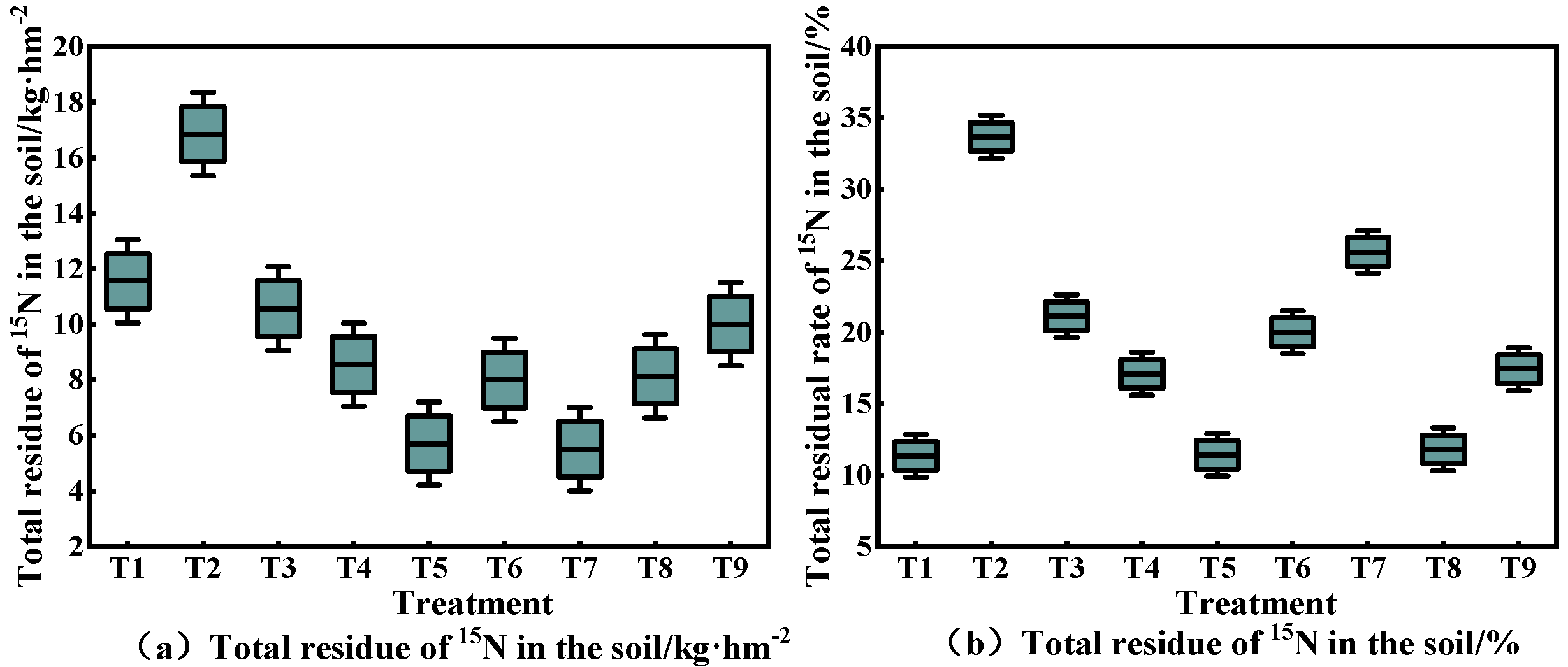
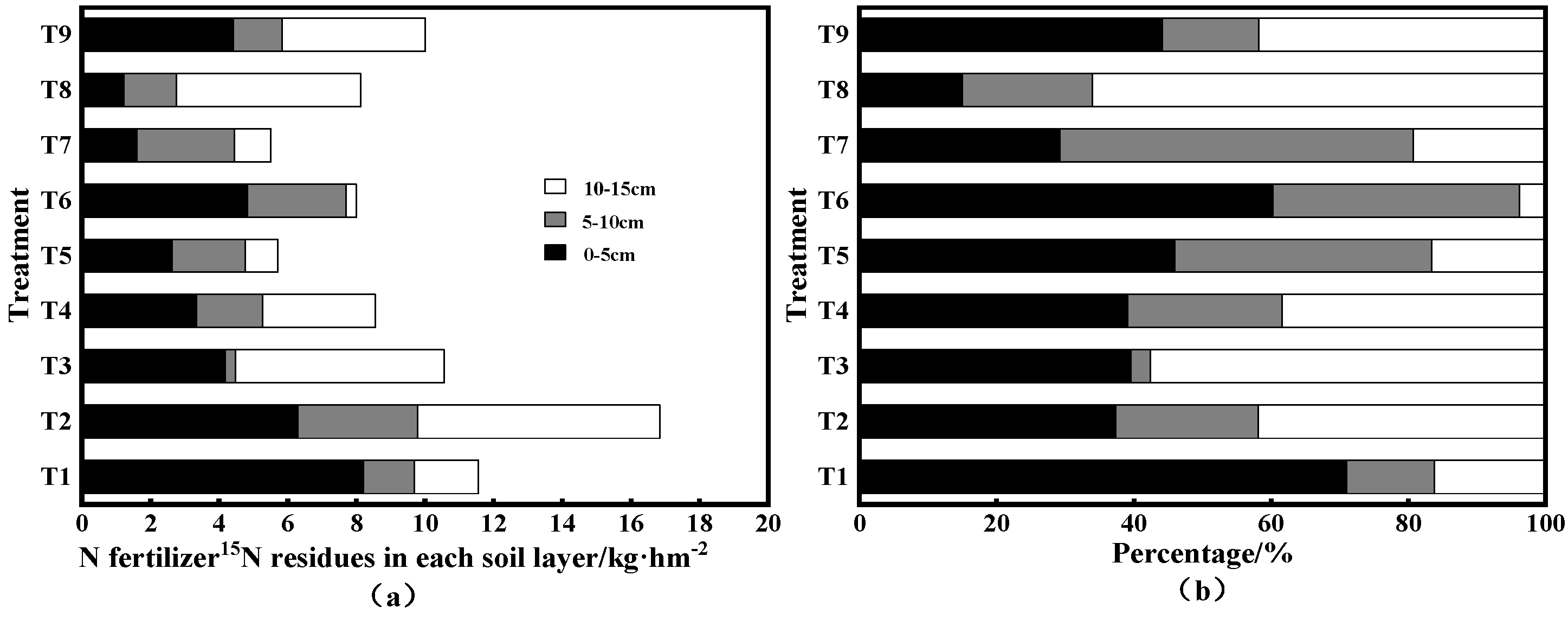
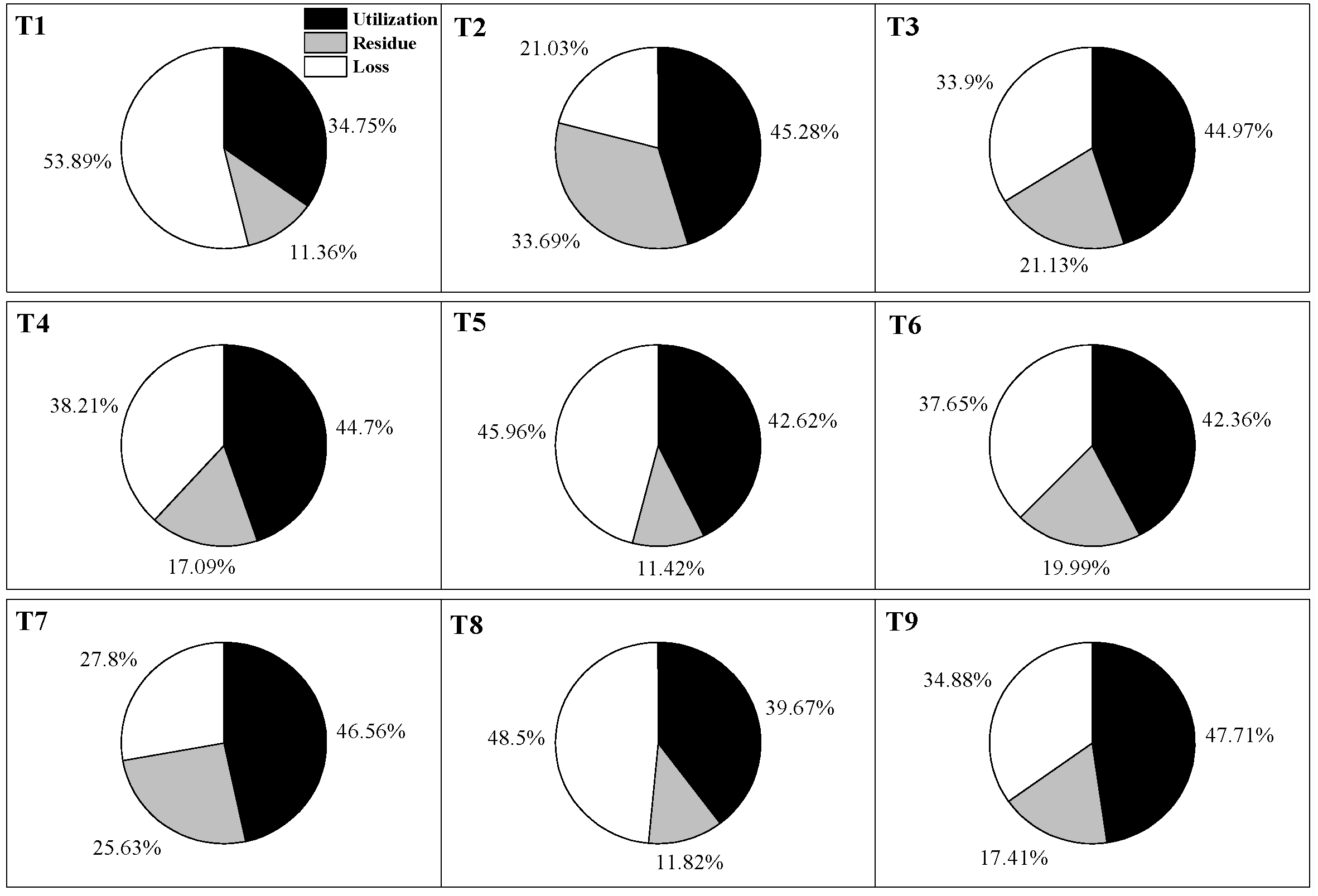

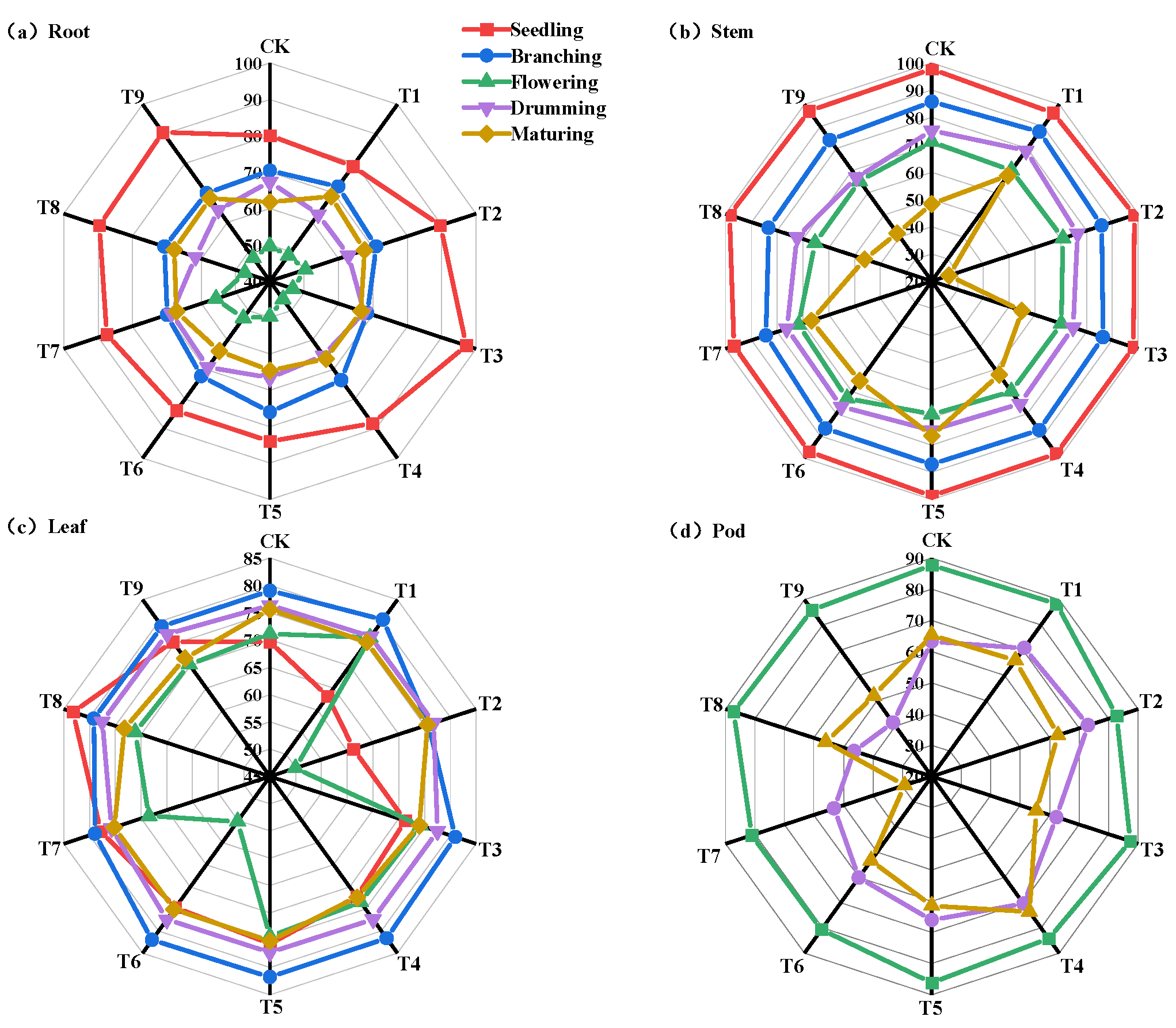
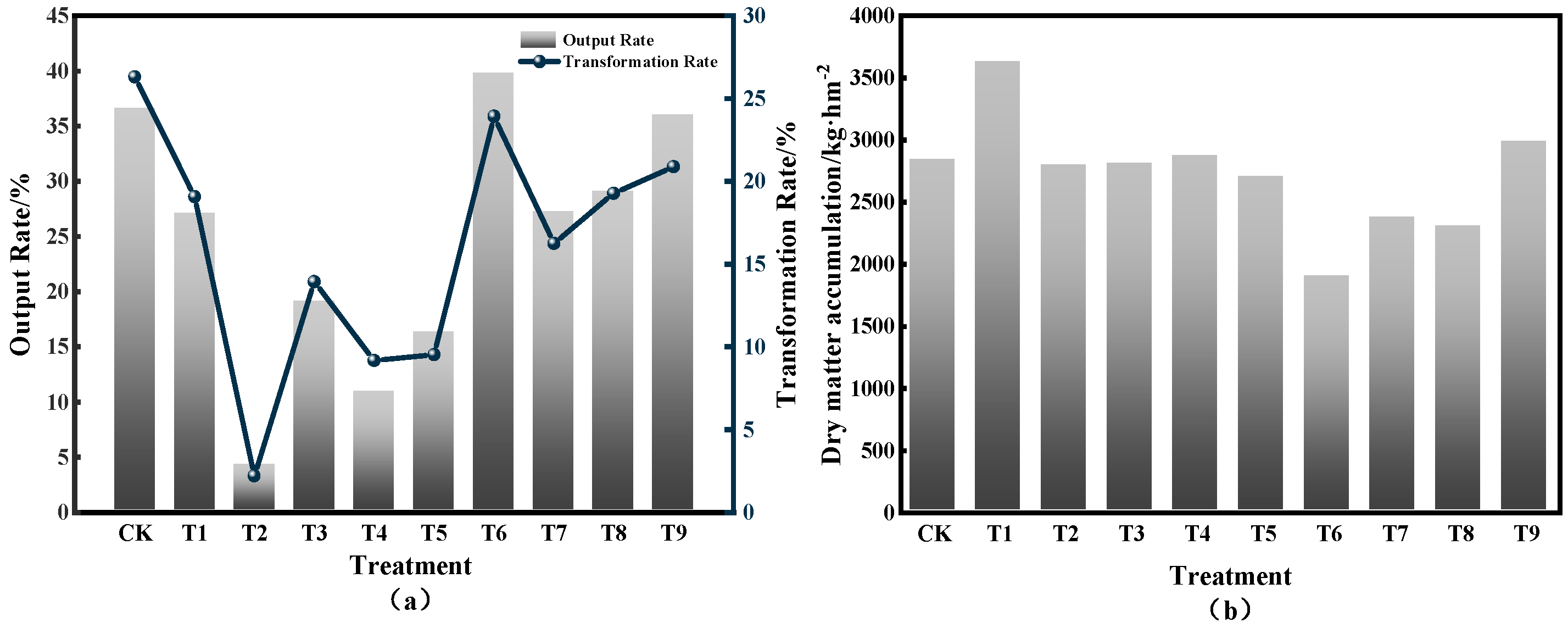
| PH | Organic Matter g·kg−1 | Alkali-Hydro Nitrogen mg·kg−1 | Available Phosphorus mg·kg−1 | Available Potassium mg·kg−1 |
|---|---|---|---|---|
| 8.13 | 22.37 | 74.75 | 21.87 | 110 |
| Number | Treatments | Nitrogen + Organic Fertilizer (kg/hm2) | Urea: Pure Nitrogen Amount (kg/hm2) | Organic Fertilizer: Pure Nitrogen Amount (kg/hm2) | Total Nitrogen Content (kg/hm2) |
|---|---|---|---|---|---|
| T1 | nitrogen fertilizer | 193.97 + 0 | 90 | 0 | 90 |
| T2 | nitrogen fertilizer + humic acid | 107.76 + 2000 | 50 | 40 | 90 |
| T3 | nitrogen + bio-organic fertilizer | 107.76 + 1460 | 50 | 40 | 90 |
| T4 | nitrogen fertilizer + biochar | 107.76 + 4706 | 50 | 40 | 90 |
| T5 | nitrogen fertilizer + straw organic fertilizer | 107.76 + 3077 | 50 | 40 | 90 |
| T6 | nitrogen fertilizer + humic acid | 86.21 + 2500 | 40 | 50 | 90 |
| T7 | nitrogen fertilizer + bio-organic fertilizer | 46.34 + 2500 | 21.5 | 68.5 | 90 |
| T8 | nitrogen fertilizer + biochar | 148.17 + 2500 | 68.75 | 21.25 | 90 |
| T9 | nitrogen fertilizer + straw organic fertilizer | 123.92 + 2500 | 57.5 | 32.5 | 90 |
| CK | no fertilizer | 0 | 0 | 0 | 0 |
Disclaimer/Publisher’s Note: The statements, opinions and data contained in all publications are solely those of the individual author(s) and contributor(s) and not of MDPI and/or the editor(s). MDPI and/or the editor(s) disclaim responsibility for any injury to people or property resulting from any ideas, methods, instructions or products referred to in the content. |
© 2023 by the authors. Licensee MDPI, Basel, Switzerland. This article is an open access article distributed under the terms and conditions of the Creative Commons Attribution (CC BY) license (https://creativecommons.org/licenses/by/4.0/).
Share and Cite
Zheng, E.; Zhu, Y.; Qin, M.; Chen, P.; Liu, M.; Qi, Z. Effects of Organic Fertilizer Replacement Nitrogen Fertilizer on Nitrogen Utilization and Growth of Mung Bean: Evidence from 15N-Tracing Technology. Agronomy 2023, 13, 235. https://doi.org/10.3390/agronomy13010235
Zheng E, Zhu Y, Qin M, Chen P, Liu M, Qi Z. Effects of Organic Fertilizer Replacement Nitrogen Fertilizer on Nitrogen Utilization and Growth of Mung Bean: Evidence from 15N-Tracing Technology. Agronomy. 2023; 13(1):235. https://doi.org/10.3390/agronomy13010235
Chicago/Turabian StyleZheng, Ennan, Yinhao Zhu, Mengting Qin, Peng Chen, Ming Liu, and Zhijuan Qi. 2023. "Effects of Organic Fertilizer Replacement Nitrogen Fertilizer on Nitrogen Utilization and Growth of Mung Bean: Evidence from 15N-Tracing Technology" Agronomy 13, no. 1: 235. https://doi.org/10.3390/agronomy13010235
APA StyleZheng, E., Zhu, Y., Qin, M., Chen, P., Liu, M., & Qi, Z. (2023). Effects of Organic Fertilizer Replacement Nitrogen Fertilizer on Nitrogen Utilization and Growth of Mung Bean: Evidence from 15N-Tracing Technology. Agronomy, 13(1), 235. https://doi.org/10.3390/agronomy13010235






